Sublease Agreement Templates
Tenants typically rent an entire property or space. However, lifestyle changes may happen during the course of their lease agreement. This occurs when family members move out, clutter is disposed, or additional income is needed. One great idea to maximize spare rooms or extra spaces is to rent it out to a third-party, commonly known as a “sublease.”

Build Your Document
Answer a few simple questions to make your document in minutes
Save and Print
Save progress and finish on any device, download and print anytime
Sign and Use
Your valid, lawyer-approved document is ready
What is a Sublease Agreement?
A sublease occurs when the original tenant leases out a smaller space inside the entire property. The tenant who has signed a prime or original lease can act as the “landlord” in this case. Since sublease agreements involve a third-party tenant who may be oblivious to the prime lease, it is, therefore, the sublessor’s responsibility to ensure that both agreements are seamlessly enforceable.
Here are some important definitions that you will encounter in a subleasing agreement:
- Prime Lease Agreement — The prime lease refers to the original residential lease agreement between the property owner and the primary tenant. This term is used throughout the sublease agreement to clearly distinguish between the two contracts. This is also called the “original lease” or “master lease”.
- Sublease Agreement — The additional contract between the third-party tenant (subtenant) and the primary tenant (sublessor). This is also called a “sublet agreement” or “subletting agreement”.
- Sublessor — This refers to the original tenant who has the responsibility for the entire property rented under the prime or original contract.
- Subtenant — This is the third-party tenant who rents out a smaller space within the property.
- Leased Premises – This refers to the smaller area being rented by the subtenant.
- Property — This term pertains to the entire area or property being rented by the tenant or sublessor.
Consent to Sublease Form — This document enables a tenant to get the landlord’s permission to sublet the leased property or its part.
When to Opt for a Sublease Agreement
When you have extra space
Only enter into a sublease agreement if your extra space has been unused for a long time. It will be a big inconvenience for the subtenant if you still use the space he or she is paying for.
When you need to vacate the premises early
Instead of ending the master lease or original lease earlier and forfeiting your security deposit, why not get a tenant to finish the contract for you? A sublease is not limited to a smaller space in the entire property. It can be extended to the entire property itself. The new tenant (subtenant) can rent the entire property while agreeing to continue your contract.
When you are in need of extra income
Desperate times mean desperate measures. One way to sustain your cash flow is by renting out that unused space. By welcoming a subtenant, you can make extra income.
When a relative wants to live with you
If family members are going to live with you for a long time, why not let them enter into a sublease? Formally entering into a sublease agreement makes sure that promises are kept and that financial responsibilities are kept in check. Plus, you won’t have to worry about security and trust if you have your family member as a subtenant.
How Do You Sublease?
Step 1 — Photocopy the prime (original) agreement.
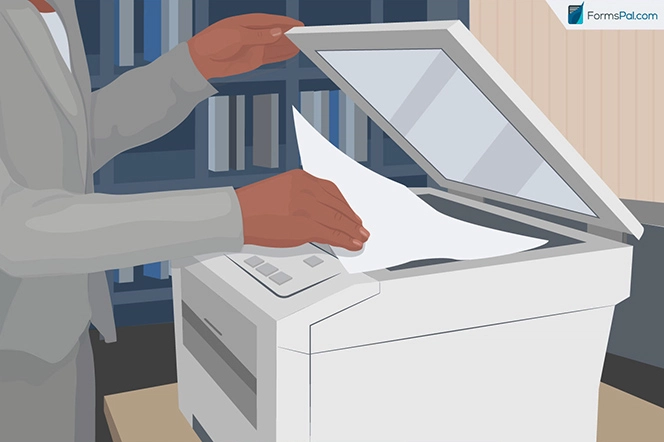
Find your original agreement and photocopy it. This will allow you to highlight important provisions so that nothing is missed when you draft the sublease agreement. You may also show this to your subtenant if ever he or she requests it.
Step 2 — Secure the owner’s approval.

If the original agreement does not say anything about subleasing, check with the original landlord. Whether governing laws state that you should get your landlord’s signature or not, it’s best to inform him or her.
Step 3 — Calculate your monthly rent.
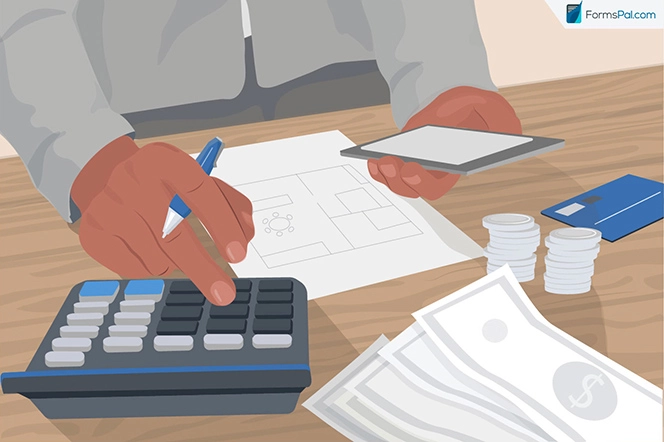
Measure the total floor space in square feet of the area you want to rent out. Compare with your existing rent per square feet and calculate how much you should charge.
Step 4 — Set-up the space.

Like a regular rental, the space must be in good condition so that you can get inquiries. Set it up and take pictures. Make sure that the room design fits the personality and demographics of your ideal subtenant.
Step 5 — Find a subtenant.

Once you have the rent amount and pictures of the room or space, list it online. Alternatively, you may have it published in the local newspaper.
Step 6 — Finalize the sublease agreement.

Talk with your prospective subtenant and agree on the provisions of your sublease contract. You may draft one using our free sublease agreement below. This is fully editable, so you can easily make changes during your negotiation with the subtenant.
Sublease Agreement Form Details
| Document Name | Sublease Agreement Form |
| Other Names | Sublease Contract, Subletting Contract |
| Avg. Time to Fill Out | 9 minutes |
| # of Fillable Fields | 33 |
| Available Formats | Adobe PDF |
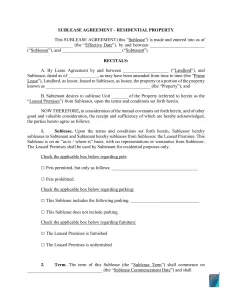
Filling Out a Sublease Agreement
Step 1 — Choose your preferred program and download the file.
Download either of the two file types. They must be compatible with your computer’s existing programs:
- Sublease Agreement Template – Open Office Format (.odt)
- Sublease Agreement Template – Microsoft Office Format (.docx)
If the file opens, you’re good to go and may now proceed to the next step.
However, if the file does not open, it may mean that you do not have the right program.
Step 2 — Fill out the opening declaration.

Begin the sublease agreement by typing the general details inside the opening paragraph:
- Blank 1: Date when the sublease agreement was signed by the primary tenant and the subtenant.
- Blank 2: Full name of the primary tenant or otherwise called the “Sublessor”. This person also holds the original residential contract with the landlord or property owner.
- Blank 3: Full name of the third-party tenant or otherwise known as the “subtenant”. Instead of renting a smaller residential property, he or she will rent a room or space in a bigger property.
Step 3 — Complete the sublease agreement recitals.
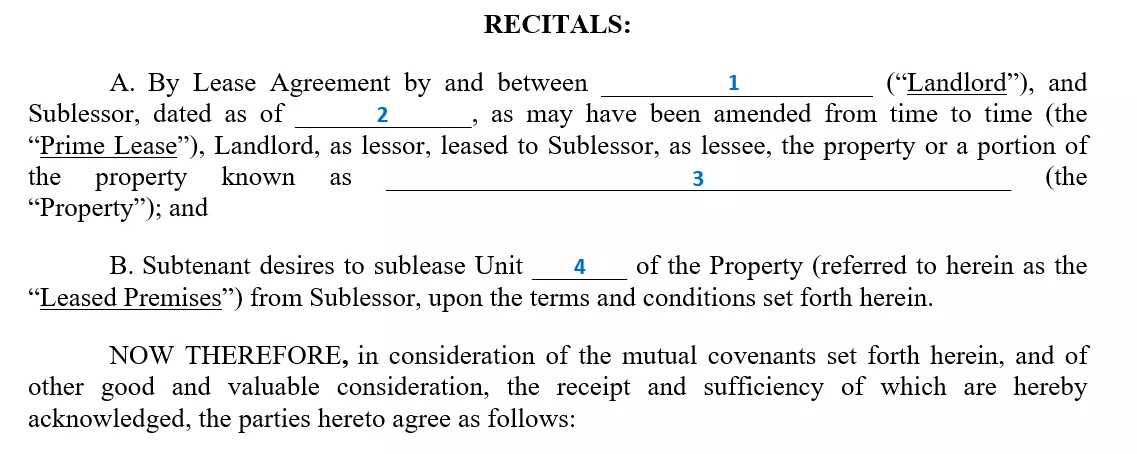
For the recitals, the following should be typed or written on the following blanks:
- Blank 1: Full name of the landlord. He or she may be the actual owner or main landlord of the leased premises.
- Blank 2: Write the same date (“effective date”) in the opening paragraph.
- Blank 3: Indicate the registered complete address of the entire property. This includes the unit or apartment number, floor, house number, street name, county/city, state, and zip code. To do this more accurately, refer back to the original rental agreement and simply copy the address from there.
- Blank 4: Write the specific room, floor, or space in the property, which will be rented out to the subtenant. If the property does not have formal room numbers, you may simply assign codes to the rooms. (e.g. “Room C”). Alternatively, you may describe the space (e.g. “First floor” or “Basement”). Make sure that the subtenant is well aware of the premises’ layout.
Step 4 — Indicate the amenities and terms.

Section 1 of the agreement details the amenities and general provisions. You may tick the box that applies for each part.
- Part 1: If pets are allowed, select the first box and write the corresponding pet policy (e.g. “Only dogs and cats are allowed,” “Pets must not be noisy,” and so on.)
- Part 2: Tick the first box if parking is provided. Make sure to include the parking rent amount when quoting the monthly rent payment. If this is not applicable, simply tick the second box.
- Part 3: The primary tenant must consider whether or not it is advantageous to have the room fully-furnished or unfurnished. If the room is ready for occupancy and has furniture, select the first box. If not, choose the second box.
Note: “As-is where-is basis” – This phrase means that the unit or space is acceptable in its current state.
Step 5 — Identify the duration of the sublease.

Now, for section 3, the term must be stipulated in the sublease agreement. Before filling this out, the original tenant must make sure that he or she has already secured a long-term contract with the original landlord or lessor.
- Part 1: On the blank provided, write the date when the subtenant can occupy the subleased space.
- Part 2: Now comes the tricky part— determining when the agreement for sublease ends. If the master lease between the original landlord and the tenant (the sublessor) is under a short-term lease (month-to-month renewal basis), tick the first box. By choosing this arrangement, the subtenant agrees that the sublease can be terminated once the original lease is terminated. One downside of this is the subtenant has no security in living in that property. On the other hand, if the primary tenant is under a long-term original contract, then simply tick the second box. Then, write the duration (e.g. three months) on the blank provided. By far, this is a much better arrangement because the subtenant can be sure that he or she can stay in that address for a fixed duration.
Step 6 — Write down the financial aspects of the sublease.
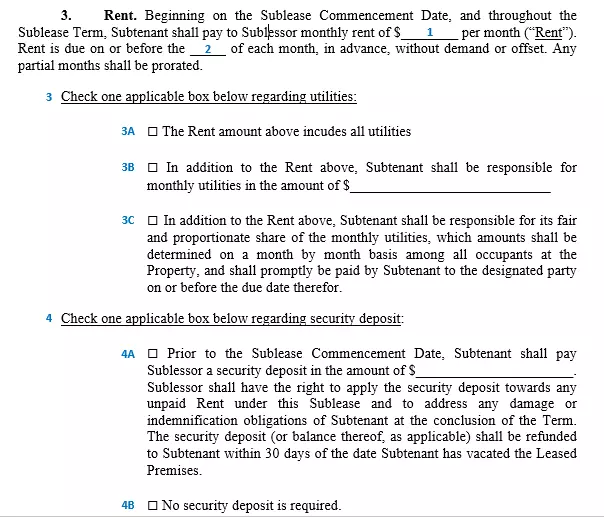
Just like any residential rental contract, a sublease agreement adheres to the same financial obligations. In this section, the following should be supplied:
- Blank 1: Write the base amount for the rent in cardinal format (e.g. “$200.00”).
- Blank 2: Then, write the day of the month using the ordinal format (e.g. “5th”).
- Part 3: This talks about utilities. Tick the first box (3A) if the rent payment in blank 1 already includes utilities. On the other hand, tick the second box (3B) if some of the utilities will be shouldered by the subtenant. You may write a fixed amount on the blank provided. Lastly, tick the third box (3C) if the subtenant will pay a percentage of the utility bills or if he or she will pay based on a submeter installed in the subleased unit.
- Part 4: This part deals with the security deposit. Choose the first box (4A) if the original tenant will keep a security deposit. Then, write the amount of the security deposit on the blank provided. Base rent payments usually have a cap of 150%. If this arrangement is not applicable, the sublessor may tick the second box (4B).
The subtenant and the original tenant must also agree on the payment type that is convenient and acceptable to both. This may be through bank transfer or through post-dated checks. If a property manager visits the premises often, the subtenant may opt to give it to him or her. Otherwise, payments are typically handed to the original tenant.
Step 7 — Review the standard paragraphs.
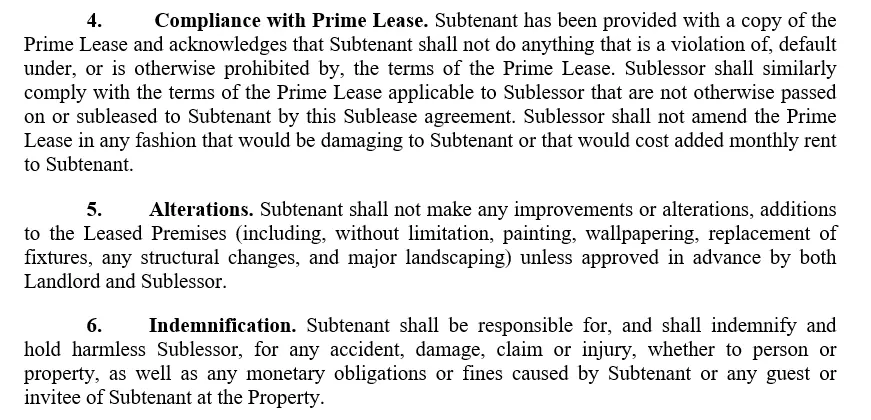
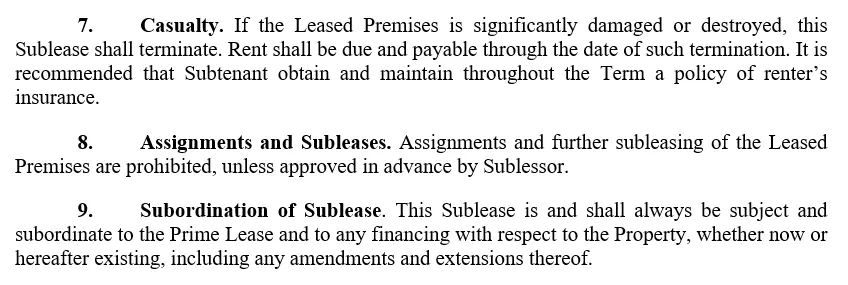
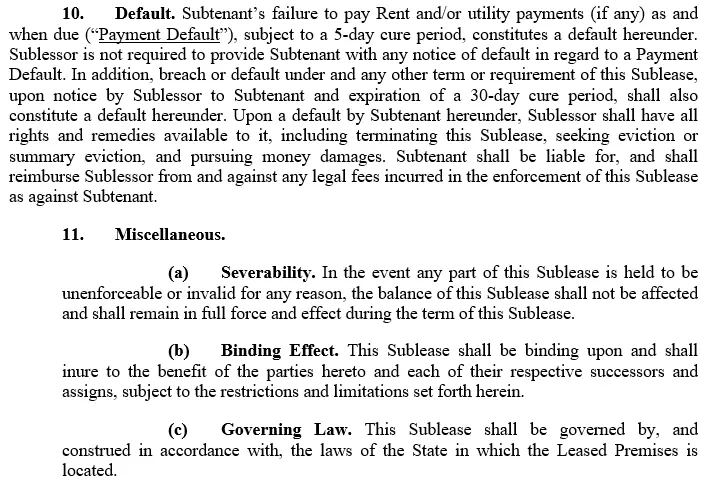
Sections 4 to 11 are all standard provisions in residential leases. It is best if both the original tenant and the subtenant review these terms before signing the sublease agreement. If there is a need to revise any of these, FormsPal recommends consulting with a lawyer or any legal counsel.
Step 8 — Affix your signature (for the sublessor and the sublessee).
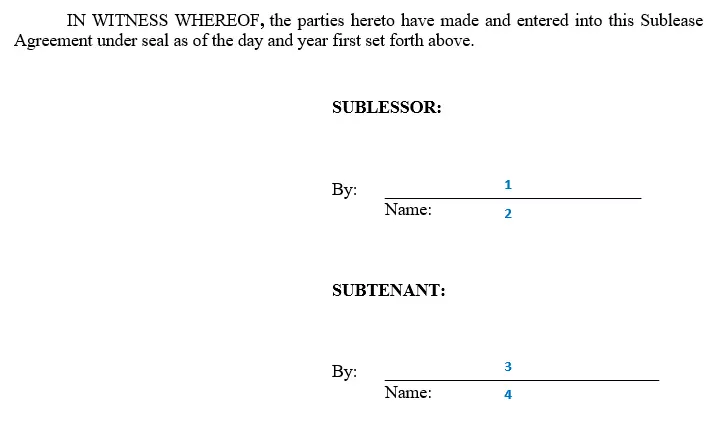
Once both the subtenant and the primary tenant agree to the terms set forth in the sublease agreement, they must sign all pages. Then, for the second to the last page, they should write the following:
- Part 1: In this blank, the sublessor must affix his or her signature.
- Part 2: Then, the sublessor or primary tenant must write his or her full name in print.
- Part 3: Next, the subtenant must sign on the space provided.
- Part 4: Lastly, let the subtenant write his or her name in this area.
Step 9 — Secure landlord approval.
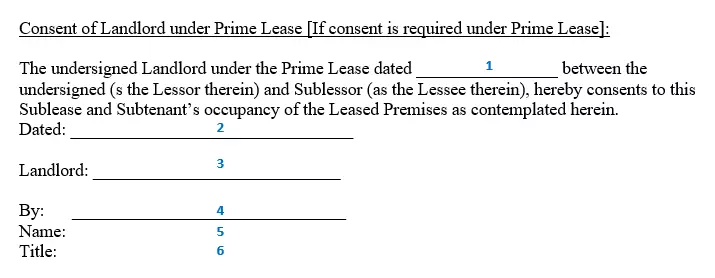
Laws vary from state to state. Though most require original lease (also called “prime” or “master lease”) tenants to obtain the permission of the original landlord, some states do not have a fixed governing law. Regardless of where the property is located, it is still best to inform the landlord and respect him or her by properly asking for permission to sublease. The last page of the agreement allows you to do this.
- Part 1: Refer back to the master lease (the original contract). Simply copy the “effective date” from that agreement to this blank.
- Part 2: Write the date when the primary landlord gave the consent.
- Part 3: On this blank, write the full name of the company that owns the property. If the property owner o is a single person, write the full name of that person.
- Part 4: Signature of the company representative or the individual landlord.
- Part 5: If the master lease landlord is a company, indicate the full name of the company representative. If not, rewrite the full name of the original landlord.
- Part 6: Write the position of the company representative here. For an individual landlord, leave this blank.
Step 10 —Add riders to the agreement.
Since the original tenant and the subtenant will typically share the premises, both parties can attach the following riders if applicable:
- House rules
- Lead paint disclosure (may be photocopied from the master contract)
- Additional information about the premises
- Additional contact information of the subtenant and the primary tenant
Frequently Asked Questions
What property can be covered by a sublease agreement?
Any property can be used for sublease as long as:
- The original landlord agrees
- The original lease allows a sublease agreement
- A sublease agreement is acknowledged and allowed by state laws
- The subtenant agrees that the property or space is habitable
Is it required to have a written sublease agreement?
Though a verbal sublease contract is legally enforceable, the hearsay nature of this agreement will make legal proceedings chaotic. Therefore, it is highly encouraged that a sublease agreement is written so that both the primary tenant and subtenant can rest assured that conditions in the agreement will be followed.
How to terminate a sublease agreement?
Terminating a sublease agreement is similar to any lease. The subtenant must simply write to the original tenant that he or she will be terminating it early. The subtenant must then go through the turnover process as agreed upon. However, this may mean that the security deposit will be forfeited.
You may refer to Section 2 (Lease Term) of our free downloadable template.
Is it safe to sublease?
There will always be security concerns when you sublease. To avoid safety issues and property damage, make sure to do a full background check on your subtenant. It is important to note, however, that in a sublease, the original tenant is still fully responsible for the entire property. If the subtenant violates the prime or master lease, the original tenant must immediately make amends. In some states, the primary tenant can be spared from damages caused by the subtenant if a waiver between the three parties has been signed. On the other hand, if the subtenant has paid a security deposit, then it shall be used to amend the problem.
Where to report sublease income?
The primary tenant’s additional income will be reported to the Internal Revenue Service using Form “Schedule E (Form 1040 or 1040-SR), Supplemental Income and Loss”. At the beginning of the rent, the security deposit given by the subtenant should also be reported. These are then typically adjusted when lease terms end and deposits are returned.
A sublease agreement is a great way to make use of extra space to gain another source of income. Still, it comes with its pros and cons. The original tenant (sublessor) must weight this advantage against security concerns, additional responsibilities, and the effort of writing a sublease agreement. To make the subleasing process easier, you may download our free agreement template above.
